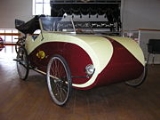
Velomobile
Encyclopedia
A velomobile or bicycle car is a human-powered vehicle, enclosed for aerodynamic advantage and protection from weather and collisions. They are virtually always single-passenger vehicles. They are derived from recumbent bicycle
s and tricycle
s, with the addition of a full fairing (aerodynamic shell). There are few manufacturers of velomobiles; some are homebuilt. Some models have the operator's head exposed; this has the advantage of giving the operator unobstructed vision, hearing, and some cooling, with the disadvantage of being more exposed to weather and less aerodynamic. Similar vehicles that are not human-powered are instead called microcar
s.

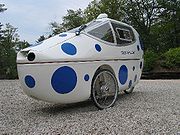
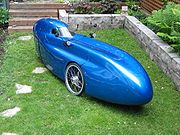
 Before World War I, Charles Mochet built a small 4 wheeled bike-car for his son. Mochet built many models of small vehicles called "Velocar
Before World War I, Charles Mochet built a small 4 wheeled bike-car for his son. Mochet built many models of small vehicles called "Velocar
". Some models had two seats, most were pedal powered but as the years went by, many were fitted with small engines.
In the 1970s the PPV or People powered vehicle
was produced. It was a two seat, "Sociable" tandem with a steel sub frame and molded plastic body. It was actually well designed, and relatively light, though weighing over 50 kg (100 lbs),(a recently restored version weighs 59 kg (131 lbs)) but had flaws in the execution that doomed it as a practical, every day vehicle. Positive features such as easily adjustable and comfortable seats, independent pedaling for both passenger and driver, adequate cargo space and relatively good weather protection could not overcome the negative features such as a complex, heavy and badly spaced 3 speed gear box, ineffective brakes, and pedals that slid on sleeve bearings on steel shafts which made it difficult to use as an everyday vehicle.
In Sweden
a design called Fantom
was sold as blueprints and became very popular, over 100,000 copies of the blueprints were sold, but few were actually completed. In the 1980s Fantomen was rediscovered by Carl-Georg Rasmussen who built a redesigned version called Leitra
. The downfall of the bicycle car came when economy improved and people chose motorised transport.
All current velomobiles are produced in low volume. The only attempt at a mass-produced velomobile which was in the mid eighties flopped. This was the Sinclair C5
. The C5 was a delta trike (one front, two rear wheels) with electric assist designed to be massed produced and sold for a low price. The C5 was poorly designed; it was heavy, had only one gear and had no adjustment for the distance between the pedals and the seat which is important to get a comfortable pedaling position.
A concept and a potential assessment concerning low-cost velomobiles for daily short trips as well as strategies for reaching a critical lot size for mass production was subject of a research project called RegInnoMobil.
Recently, some velomobiles have been converted to provide electric-assist. Electric assist means that a small battery operated electric propulsion system is provided to assist the driver's leg muscle effort. Most Electric-assist propulsion motors are of the inwheel design, such as the Heinzman electric motor or the Bionx. While an electric-assist unit does add extra weight to the velomobile, it is somewhat offset by the flexibility it also provides, especially during hill climbs.
These have also been used in Pedal Prix since 1985.
is currently the velomobile which has been in commercial production for the longest period of time — since 1983. Other manufacturers include:
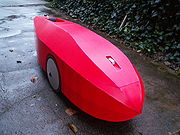
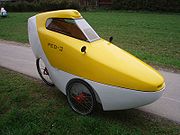
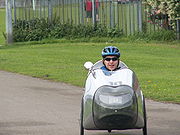
 A practical velomobile has many competing requirements. It should have as many of the following characteristics as possible.
A practical velomobile has many competing requirements. It should have as many of the following characteristics as possible.
ists have endeavored to build their own velomobiles from kits, sourced components, or from scratch. When compared to similar sized commercial velomobiles, the DIY velomobiles tend to be cheaper.
Recumbent bicycle
A recumbent bicycle is a bicycle that places the rider in a laid-back reclining position. Most recumbent riders choose this type of design for ergonomic reasons; the rider's weight is distributed comfortably over a larger area, supported by back and buttocks...
s and tricycle
Tricycle
A tricycle is a three-wheeled vehicle. While tricycles are often associated with the small three-wheeled vehicles used by pre-school-age children, they are also used by adults for a variety of purposes. In the United States and Canada, adult-sized tricycles are used primarily by older persons for...
s, with the addition of a full fairing (aerodynamic shell). There are few manufacturers of velomobiles; some are homebuilt. Some models have the operator's head exposed; this has the advantage of giving the operator unobstructed vision, hearing, and some cooling, with the disadvantage of being more exposed to weather and less aerodynamic. Similar vehicles that are not human-powered are instead called microcar
Microcar
A microcar is the smallest automobile classification usually applied to standard small car . Such small cars were generally referred to as cyclecars until the 1940s. More recent models are also called bubblecars due to their egg-shaped appearance.-Definition:The definition of a microcar has varied...
s.
History




Velocar
Velocar was the name given to velomobiles made in the 1930s and 40s by Mochet et Cie of Puteaux, France....
". Some models had two seats, most were pedal powered but as the years went by, many were fitted with small engines.
In the 1970s the PPV or People powered vehicle
People powered vehicle
The People Powered Vehicle, or PPV, was a 2-person pedal-powered car introduced in the United States during the oil crisis of the early 1970's. Manufactured by EVI of Sterling Heights, Michigan, it sold for less than $400...
was produced. It was a two seat, "Sociable" tandem with a steel sub frame and molded plastic body. It was actually well designed, and relatively light, though weighing over 50 kg (100 lbs),(a recently restored version weighs 59 kg (131 lbs)) but had flaws in the execution that doomed it as a practical, every day vehicle. Positive features such as easily adjustable and comfortable seats, independent pedaling for both passenger and driver, adequate cargo space and relatively good weather protection could not overcome the negative features such as a complex, heavy and badly spaced 3 speed gear box, ineffective brakes, and pedals that slid on sleeve bearings on steel shafts which made it difficult to use as an everyday vehicle.
In Sweden
Sweden
Sweden , officially the Kingdom of Sweden , is a Nordic country on the Scandinavian Peninsula in Northern Europe. Sweden borders with Norway and Finland and is connected to Denmark by a bridge-tunnel across the Öresund....
a design called Fantom
Fantom
Fantom is a Swedish velomobile with three wheels, two in the front and one in the rear. It has no front suspension, but has suspension in the rear....
was sold as blueprints and became very popular, over 100,000 copies of the blueprints were sold, but few were actually completed. In the 1980s Fantomen was rediscovered by Carl-Georg Rasmussen who built a redesigned version called Leitra
Leitra
Leitra is a Danish company and also the name of the velomobile it makes. In Sweden a design for two persons called Fantom was sold as blueprints in the 1930s and 40s.Many thousands of DIY instructions were sold, but very few were actually built....
. The downfall of the bicycle car came when economy improved and people chose motorised transport.
All current velomobiles are produced in low volume. The only attempt at a mass-produced velomobile which was in the mid eighties flopped. This was the Sinclair C5
Sinclair C5
The Sinclair Research C5 is a battery electric vehicle invented by Sir Clive Sinclair and launched by Sinclair Research in the United Kingdom on 10 January 1985. The vehicle is a battery-assisted tricycle steered by a handlebar beneath the driver's knees. Powered operation is possible making it...
. The C5 was a delta trike (one front, two rear wheels) with electric assist designed to be massed produced and sold for a low price. The C5 was poorly designed; it was heavy, had only one gear and had no adjustment for the distance between the pedals and the seat which is important to get a comfortable pedaling position.
A concept and a potential assessment concerning low-cost velomobiles for daily short trips as well as strategies for reaching a critical lot size for mass production was subject of a research project called RegInnoMobil.
Recently, some velomobiles have been converted to provide electric-assist. Electric assist means that a small battery operated electric propulsion system is provided to assist the driver's leg muscle effort. Most Electric-assist propulsion motors are of the inwheel design, such as the Heinzman electric motor or the Bionx. While an electric-assist unit does add extra weight to the velomobile, it is somewhat offset by the flexibility it also provides, especially during hill climbs.
These have also been used in Pedal Prix since 1985.
Manufacturers
The LeitraLeitra
Leitra is a Danish company and also the name of the velomobile it makes. In Sweden a design for two persons called Fantom was sold as blueprints in the 1930s and 40s.Many thousands of DIY instructions were sold, but very few were actually built....
is currently the velomobile which has been in commercial production for the longest period of time — since 1983. Other manufacturers include:
- Alleweder (Netherlands)
- Bike Revolution (Austria)
- Birkenstock Bicycles (Switzerland)
- bluevelo (Canada)
- Cab-Bike (Germany)Cab-bikeThe Cab-Bike is a velomobile that has been in production since 1998. Designed by Reihold Schwemmer and manufactured by Germany Eslava, it was developed as a vehicle that would permit year-round commuting...
- CabrioVelo (Germany)
- Easy Racers (USA)
- Fietser.be WAW (Belgium)
- Flevobike (Netherlands)
- go-one (Germany, USA)
- Greenspeed (Australia)
- Liberty Velomobiles (USA)
- Lightfoot Cycles (USA)
- Ped-3 (Slovenia)
- RJK (Spain)
- Schöne Linie (Germany)
- Sinner Ligfietsen (Netherlands)
- Sunrider Cycles (Netherlands)
- Velocity Velos (US)
- Veloform (Germany)
- Velomobiel.nl (Netherlands)
- WeatherVelo (UK, Germany)
Characteristics




- Light weight
- Good visibility for the operator (clear front vision is especially important, but a 360 degree view is also desirable).
- Adjustable seating
- Maneuverability (steering, braking)
- Roll stability (steering, braking and adverse camber)
- SafetySafetySafety is the state of being "safe" , the condition of being protected against physical, social, spiritual, financial, political, emotional, occupational, psychological, educational or other types or consequences of failure, damage, error, accidents, harm or any other event which could be...
in collision and over bad roads - Ventilation, including a windscreen defroster / demister. This should be adjustable for more cooling in warmer weather.
- Many gears; a vehicle that is heavier but more aerodynamic than a bicycle needs a wider gearing range than a bicycle.
- AerodynamicsAerodynamicsAerodynamics is a branch of dynamics concerned with studying the motion of air, particularly when it interacts with a moving object. Aerodynamics is a subfield of fluid dynamics and gas dynamics, with much theory shared between them. Aerodynamics is often used synonymously with gas dynamics, with...
- which allows greater speed for a given level of effort, or reduced effort on level ground and against headwinds. - Low rolling resistance - primarily dependent upon the tireBicycle tireA bicycle tire is a tire that fits on the wheel of a bicycle, unicycle, tricycle, quadracycle, bicycle trailer, or trailer bike. They may also be used on wheelchairs and handcycles, especially for racing...
s. - Enclosed wheels, aerospoked wheels, or disc wheels.
- Single-sided wheel mounts - to facilitate puncture repair, inner-tube and tire changes.
- Good suspensionSuspension (vehicle)Suspension is the term given to the system of springs, shock absorbers and linkages that connects a vehicle to its wheels. Suspension systems serve a dual purpose — contributing to the car's roadholding/handling and braking for good active safety and driving pleasure, and keeping vehicle occupants...
. - Reliable operation.
- Efficient transmissionTransmission (mechanics)A machine consists of a power source and a power transmission system, which provides controlled application of the power. Merriam-Webster defines transmission as: an assembly of parts including the speed-changing gears and the propeller shaft by which the power is transmitted from an engine to a...
. - Low maintenanceCar maintenanceAuto maintenance describes the act of inspecting or testing the condition of car subsystems and servicing or replacing parts and fluids....
, because of the fully enclosed transmission components, such as chainwheel, chain & gears. The longevity of a fully enclosed transmission is vastly greater than a bicycle. - Strong wheels, brakes, transmission, more so than on a lightweight bicycle. Velomobiles that don't lean, subject wheels to considerable lateral forces.
- Efficient brakes - an unbraked velomobile with good aerodynamics can rapidly reach dangerous speeds in a descent. Caliper brakes are unsuitable, disk brakes are rarely fitted, but are preferred for mountainous areas. Drum brakes are often used, but long steep descents can cause overheating and so fading. Some velomobile pilots use drogue parachutes as used by runners during training. These parachutes need to be stabilised to avoid tangling and offer greatly increased on long, steep descents. It may be best to use two smaller parachutes than one large, because of the sudden deceleration upon deployment. An alternative is to remove wheel fairings (if fitted) and take periodic stops to allow the brakes to cool. On tadpole types, brakes are only normally fitted to the front wheels, because a rear brake will tend to lock the rear wheel and diminish the ability to steer during hard braking.
- Parking brake - essential to prevent the velomobile rolling away.
- CargoCargoCargo is goods or produce transported, generally for commercial gain, by ship, aircraft, train, van or truck. In modern times, containers are used in most intermodal long-haul cargo transport.-Marine:...
capacity suitable for everyday shopping. - Low noise, for both the comfort of the operator and safety in traffic.
- Multiple tracks (tricycle or quadracycle design) for safety and practicality in slippery weather.
- Easy entry and exit.
- Strong headlights to identify obstacles and hazards at the high speeds
- Visibility to others. Velomobiles are unusual and much lower than conventional cycles. Also, velomobiles do not show pedaling movements and other visual clues associated with pedal cycles to other road users. Plain colours each have their own disadvantages, especially with road users unaccustomed to velomobiles, contrasting bold patterns are useful, especially those that make the velomobile resemble familiar objects. (Velomobiles in traffic). An inattentive driver may either fail to recognise an unfamiliar object such as a velomobile due to distraction / tiredness etc., or mistake a fast-moving velomobile for a car at a much greater distance (totalled Quest velomobile).
- Front, side and rear running lights, preferably strobe lights where permitted, even in daylight. A nose strobe with enhanced sideways emission to attract the attention of other road users when emerging into traffic from behind an obstacle ("creep and peep" technique). Because the pilot's head is positioned to the rear, which hinders the usual observations.
- Fluorescent colours; retroreflective decals and tyres with reflective side-walls.
- Two warning devices: a pedestrian-friendly bicycle bell and a very loud horn for motor vehicles, aggressive dogs and inattentive pedestrians with personal stereos or cell phones on cycle paths.
- Optional Safety flag for visibility in traffic. The flag increases drag, but announces the presence of the velomobile to drivers who cannot see it directly. It is best if the flag is mounted close to the front of the velomobile, to enhance visibility when emerging from a side-road. Flags are not a panacea to visibility.
- Very easy to ride.
- Low price (from around 5,000 to 10,000 USD) - currently hindered by the low volume of sales and manufacture.
DIY velomobiles
With a growing DIY-community and an increasing interest in environmentally friendly "green energy", some hobbyHobby
A hobby is a regular activity or interest that is undertaken for pleasure, typically done during one's leisure time.- Etymology :A hobby horse is a wooden or wickerwork toy made to be ridden just like a real horse...
ists have endeavored to build their own velomobiles from kits, sourced components, or from scratch. When compared to similar sized commercial velomobiles, the DIY velomobiles tend to be cheaper.

